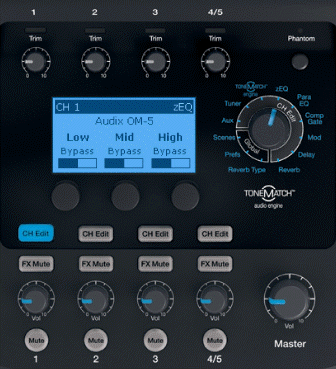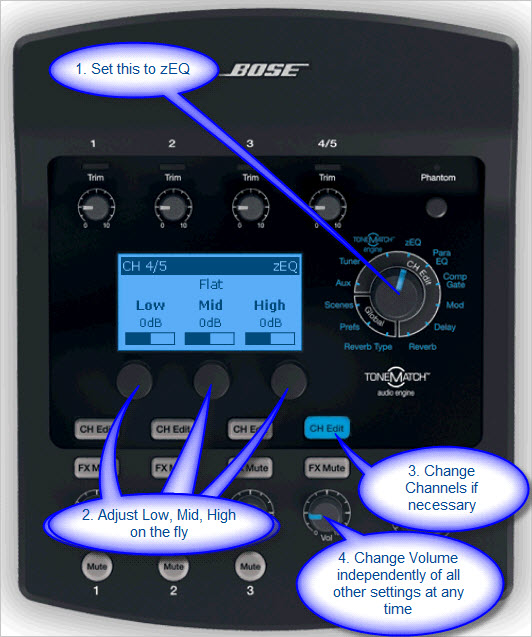ToneMatch Mixer / zEQ
Contents
Official Description
Ordinary tone controls are generic by design: “High,” “Mid” and “Low” controls are spread out across the entire musical spectrum. Proprietary zEQ automatically shifts the range of these controls so that they correspond directly to the range of your voice or instrument. zEQ gives you more precise control over your tone, making it easy to fine-tune your sound.
Source: pro.bose.com
The Problem
Most are familiar with the frustration with using the fixed tone controls on a mixer when the controls don't match the voice or instrument that's being equalized. For example, the bass control usually does nothing to equalize a trumpet. Similarly, the high tone control usually does nothing to help equalize a bass guitar.
More sophisticated parametric equalizers exist on more expensive mixers but they require a much higher level of experience to operate skillfully. The user must determine the center frequency, the width of filter (the Q) and the boost or cut.
zEQ
zEQ is a technology that's made possible by ToneMatch technology. When you select ToneMatch preset, they are helping to identify the instrument they are using (or in the case of a vocal microphone, that they're a vocalist). With this information, it's possible to design custom low, mid, and high tone controls to match the instrument or voice.
Thus, when you go to adjust the tone controls in zEQ, you will hear changes that are most useful for the instrument being used, or the human voice.
Using zEQ
Using the zEQ as a Tone Control when performing live is simple.
Quotes about zEQ from People-at-Bose
Ken-at-Bose
By selecting a ToneMatch™ preset, you're telling the T1 something about what you play or that you sing.
Once you do that, zEQ tone controls are automatically programmed to give you the three most useful tonal enhancements for that instrument or for the voice. We found these three top sensitive tonal ranges by listening.
So, for example, if you select a ToneMatch preset for an electric bass, the three tone controls are automatically programmed to provide the three most useful tonal enhancements we could find for the bass guitar.
This is profound. Think about the choices before: you'd have fixed-frequency and fixed-Q tone controls on a mixer that often didn't line up at all with what you wanted to boost or cut, or you'd have tone controls with variable frequency and Q that most people haven't a clue how to optimize.
We thought we could do all the work for you. WE took the time to explore the best center frequencies and the best Q values and custom designed three filters for each ToneMatch preset that tie to the instrument or voice.
Grab any of the three tone controls and they all do something useful.
Isn't that NEAT?
— Ken[1]
Chris-at-Bose
zEQ automatically shifts the tone control center frequencies in response to the preset setting, at the time you choose the preset. zEQ "comes with the preset", invisibly.
Example: Suppose you are a singing bass player (imagine that!). You put your mic into Input 1 and choose a vocal mic preset there, and then you put your instrument into Input 2 and choose a bass guitar preset there. Now you boost the treble on your vocal channel and notice that your voice gets brighter and has stronger sibilants. Next you boost the treble on your instrument and notice that you get more snap and harmonics. The frequency ranges boosted by the two treble controls are different and are appropriate to the ranges of the instruments designated by the presets. Automagically, no secret menu tweaking, no user serviceable parts inside. You don't have to ask for it, you just get it, every time.
How about that?
— Chris[2]
Hilmar-at-Bose
And for the techno-geeks:
We optimize not only the frequencies but also the exact shape of the tone controls. There is fairly large possible set of control shapes (notches and peaks with different widths, shelves with different steepness, spectral tilts, etc.) and we (or to be more precise Mike-Z and Cliff) have spend countless hours experimenting to find the best fit for each instrument.
The T1 supports individual zEQ settings for each preset. Although most acoustic guitar presets use the same zEQ, every now and then we find a particular model zEQ that works better with a different zEQ and we incorporate that into the specific preset for that model. Again, that's an example of "the more we know about your instrument, the better we can help you making it sound good".
Hope that helps
—Hilmar[3]
MikeZ-at-Bose
There's a preset in the T1 ToneMatch Audio Engine that is 'Flat' like 00, but has the zEQ controls for the bass - so you have the benefits of the BassPOD and zEQ.
This is true for every instrument category as well. There is a 'Flat' preset with that categories most common zEQ controls.
—MikeZ[4]
Bill-at-Bose
In response to a post from a message board post from Dan Cornett
- I recognize that the zEQ may be the same for all the Preset within one category at the present time, but I could envision some categories in the future which might warrant different zEQ ranges for the specific Preset within the category (e.g.: Double-Reeds category, with several oboe, English horn, bassoon, and contrabassoon presets for different kinds of pickups and/or mics -- or, think perhaps of a Saxophone category ... the zEQ for a bari-sax ought not be the same as for a soprano sax). — Dan Cornett
Bill-at-Bose replied
- This is one of the fascinating and non-intuitive things we found while working on zEQ. Before we tried it, it seemed obvious to us as it does to you - wouldn't the zEQ for a male vocal would be different than for a female vocal? Or bari sax different from soprano?
- But when Mike and Cliff listened to vocals and instrument families, they found that the frequencies that were useful to adjust within each category were very close: For example, the Highs that affect female voices also generally affect male voices usefully. Having the same ranges to adjust work really, really well to modify tone across the vocal mic family. Mike and Cliff tested this with a wide range of singers.
— Bill-at-Bose[5]
- ↑ Ken-at-Bose talks about zEQ
- ↑ Chris-at-Bose talks about zEQ
- ↑ Hilmar-at-Bose talks about zEQ
- ↑ MikeZ-at-Bose talks about zEQ
- ↑ Bill-at-Bose talks about zEQ


